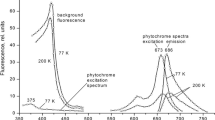Summary
As measured by in vivo spectrophotometry the phytochrome content in etiolated turnip seedlings was higher in cotyledons than in hypocotyls; in the latter, it is confined to the apical part. During early growth in darkness the amount increased in both tissues to a maximum, reached about 40 hours after sowing; the levels then gradually declined. Separation of seedlings into hypocotyl and cotyledons increased the rate of phytochrome loss in the former, but not in the latter.
Following 5 minutes of red light P frdecayed very rapidly in darkness; after 1.5 hours all of the phytochrome was present as P r, which was presumably not converted initially. In continuous red light the total phytochrome was reduced to below the detection level within 3 hours. Seedling age markedly affected the loss of phytochrome following red light; more was destroyed in older than in younger hypocotyls and apparent new synthesis occurred only in young seedlings. The capacity to synthesise phytochrome differed in cotyledons and hypocotyl. In cotyledons, synthesis occurred following shots of red light varying from 10 seconds, to 6×I minute, but the amount of newly formed phytochrome was not related to the amount destroyed: after 5 hours of continuous red light no new synthesis occurred. In hypocotyls, the amount of phytochrome synthesised was related to the amount previously destroyed, and the phytochrome content after 24 hours of darkness was similar following all red light treatments of 1 minute or longer: new synthesis occurred following 5 hours of continuous red light.
In far-red light phytochrome decayed very slowly, approaching the limit of detection after 48 hours. In cotyledons some loss was already observed after 5 hours of far-red and, in hypocotyls, after about 10 hours.
These results are discussed in relation to the possible role of phytochrome as the pigment mediating anthocyanin synthesis in prolonged far-red light.
Similar content being viewed by others
References
Butler, W. L., S. B. Hendricks, and H. W. Siegelman: Action spectra of phytochrome in vitro. Photochem. and Photobiol. 3, 521–528 (1964).
—, and H. C. Lane: Dark transformations of phytochrome in vivo. II. Plant Physiol. 40, 13–17 (1965).
——, and H. W. Siegelman: Nonphotochemical transformations of phytochrome in vivo. Plant Physiol. 38, 514–519 (1963).
Clarkson, D. T., and W. S. Hillman: Stability of phytochrome concentration in dicotyledonous tissues under continuous far-red light. Planta (Berl.) 75, 286–290 (1967a).
——: Apparent phytochrome synthesis in Pisum tissue. Nature (Lond.) 213, 468–470 (1967b).
——: Stable concentrations of phytochrome in Pisum under continuous illumination with red light. Plant Physiol. 43, 88–92 (1968).
Furuya, M., and W. S. Hillman: Observations on spectrophotometrically assayable phytochrome in vivo in etiolated Pisum seedlings. Planta (Berl.) 63, 31–42 (1964).
Grill, R.: Photocontrol of anthocyanin formation in turnip seedlings. I. Demonstration of phytochrome action. Planta (Berl) 66, 293–300 (1965).
—: Photocontrol of anthocyanin synthesis in turnip seedlings. IV. The effect of feeding precursors. Planta (Berl.) 76, 11–24 (1967).
—: Photocontrol of anthocyanin formation in turnip seedlings. V. Differential response patterns of hypocotyls and cotyledons. Planta (Berl.) 85, 42–56 (1969).
Hartmann, K. M.: A general hypothesis to interpret ‘high energy phenomena’ of photomorphogenesis on the basis of phytochrome. Photochem. Photobiol. 5, 349–366 (1966).
Hillman, W. S.: The physiology of phytochrome. Ann. Rev. Plant Physiol. 18, 301–324 (1967).
Hopkins, W. G., and W. S. Hillman: Phytochrome changes in tissues of darkgrown seedlings representing various photoperiodic classes. Amer. J. Bot. 52, 427–432 (1965).
Kendrick, R. E., and B. Frankland: Kinetics of phytochrome decay in Amaranthus seedlings. Planta (Berl.) 82, 317–320 (1968).
Klein, W. H., J. L. Edwards, and W. Shropshire Jr.: Spectrophotometric measurements of phytochrome in vivo and their correlation with photomorphogenic responses of Phaseolus. Plant Physiol. 42, 264–270 (1967).
Lint, P. J. A. L. De, and C. J. P. Spruit: Phytochrome destruction following illumination of mesocotyls of Zea Mays L. Meded. Landbouwhogeschool. Wageningen 63, 1–7 (1963).
Meijer, G.: Rapid growth inhibition of gherkin hypocotyls in blue light. Acta bot. neerl. 17, 9–14 (1968).
Spruit, C. J. P., J. Boisard, and P. Rollin: Spectrophotometric phytochrome in imbibed seeds of dark germinating plants. Plant Physiol., Suppl. 43, 15 (1968).
Author information
Authors and Affiliations
Rights and permissions
About this article
Cite this article
Grill, R., Vince, D. Photocontrol of anthocyanin formation in turnip seedlings. Planta 89, 9–22 (1969). https://doi.org/10.1007/BF00386493
Received:
Issue Date:
DOI: https://doi.org/10.1007/BF00386493




